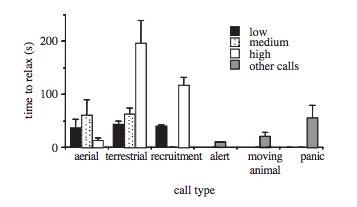Meerkat Surveyors
Biology 342 Fall 2014
Sofia Claesson
Lia Zallar
Adaptive Value

8) Image courtesy of Samim Hasan
How does variation and specificity of meerkat vocalizations increase lifetime reproductive fitness?
Meerkats forage for food with their head down and therefore are very vulnerable to predators. Meerkats utilize a wide variety of calls to communicate to one another, all of which are differentiated and have very specific meanings. By living in a complex, interdependent social group meerkat lifetime reproductive fitness is influenced largely by other individuals in the group. Their system of communication mediates the cost of their foraging technique and is essential for lifetime reproductive fitness (Townsend 2011). The ability to produce and interpret different barks for aerial and terrestrial predators is adaptive because meerkats can alter their evasion behavior based on the type of predator. In response to hearing an aerial predator bark, foraging meerkats will retreat to the nearest bolthole. Upon hearing a terrestrial predator bark, meerkats will find the signaler and gather in the safe space to decide if the group needs to change locations. These responses provide the optimal way for meerkats avoid specific predators (Manser 2001).

Call Response
Meerkats' ability to produce and recognize differences in alarm calls based of the type of predator allows them to change their behavior in response to these signals. Their altered response is adaptive because it allows for a specialized escape mechanism and increased alertness when necessary. The graph to the left shows that meerkats are more alert to terrestrial versus aerial predators for a longer period of time after an initial alarm call is made by a fellow meerkat. This increases survival value because aerial predators present a threat for a shorter period of time compared to terrestrial counterparts. The Y axis represents the number of seconds on average it took for the meerkats to relax after hearing various call types of different urgencies. After high urgency terrestrial and recruitment calls, meerkats took more time to relax compared to high urgency aerial calls. The time to relax after low and medium urgency calls was less affected by call type.